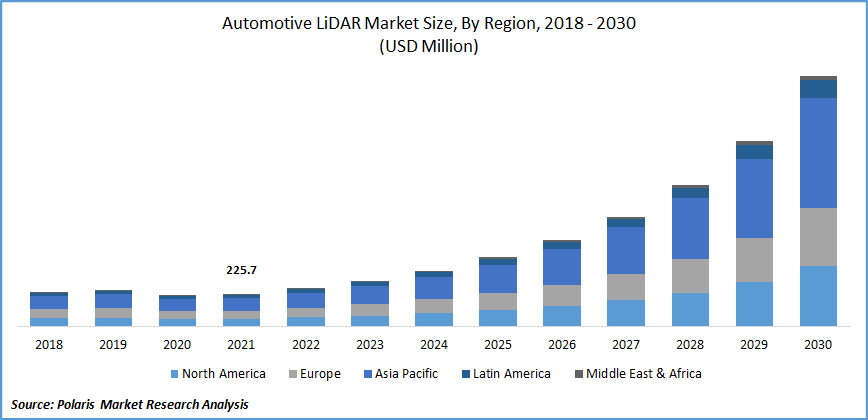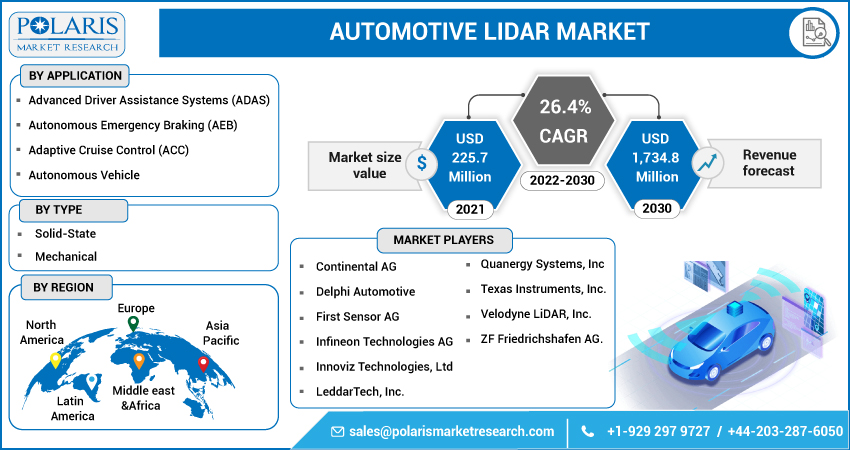
Automotive LiDAR Market Share, Size, Trends, Industry Analysis Report, By Application (Advanced Driver Assistance Systems (ADAS), Autonomous Emergency Braking (AEB), Adaptive Cruise Control (ACC), Autonomous Vehicle); By Type; By Region; Segment Forecast, 2022 - 2030
- Published Date:Jul-2022
- Pages: 118
- Format: PDF
- Report ID: PM1493
- Base Year: 2021
- Historical Data: 2018-2020
Report Outlook
The global automotive LiDAR market was valued at USD 225.7 million in 2021 and is expected to grow at a CAGR of 26.4% during the forecast period. The industry growth is attributed to the increasing demand for autonomous vehicles for active safety and self-driving.

Know more about this report: Request for sample pages
As advanced driver assistance systems (ADAS) and autonomous vehicles are expected to witness growth at significant rates, it is expected to have a direct positive impact on the change in the industry.
Several advantages are provided by vertical integration, which includes low costs due to access to aggressive international labor markets, lessening manufacturing and delivery times, and direct sourcing for raw materials. Many industry players outsource their manufacturing activities to sub-contractors and third-party contractors.
The various contenders dominating the market are challenged to offer innovative offerings, which help consumers change technologies, business practices, and security requirements, which in turn pushes the demand for the industry.
The speedy growth of covid-19 has influenced the automotive industry worldwide. They are patronizing the administration of WHO for lessening the spread of the virus; several countries have restricted the trade or set up lockdown, which has disturbed the exports of automotive parts, particularly from China, large-scale manufacturing interventions covering Europe, and the termination of assembly plants in the US.
The automotive industry is under intense pressure and is a managing slowdown in global demand. Along with disturbances in commencing supply and manufacturing processes, the company has gone down in setback with an unknown recovery timeline due to a decrease in order. The industry is anticipated to be negatively influenced due to the covid-19 pandemic.

For Specific Research Requirements, Request for a Customized Report
Industry Dynamics
Growth Drivers
Moreover, the increasing penetration of light detection and ranging-based solutions in passenger cars is another factor expected to drive the market during the forecast period. Furthermore, the rapidly increasing demand for autonomous vehicles coupled with significant partnerships of OEMs with Tier 1 IT organizations is also providing traction to the automotive LiDAR industry in the automotive segment. Emerging innovations in technology are disrupting the overall automotive industry.
The concept of the autonomous car providing decisive convenience not only improves safety but also brings other benefits. These automated vehicles offer opportunities for many firms to access a range of untapped facts, creating new revenue-generating opportunities, which will boost industry growth. Thus, the global demand is anticipated to grow exponentially.
The adoption of LiDAR technologies in automobiles has caused several newer applications are fields that would acquire light detection and ranging technology. Other than usage in automobiles, ADAS and LiDAR can be utilized in robot taxis and ride-sharing services, on-demand car services, shuttle services, and mobility-on-demand fleets.
Therefore, the high performance of LiDAR sensors has been attractive heavy investments from automotive OEMs covering the world directed at authorizing their development and acquisition of the next-generation autonomous vehicles, which subsequently is the major driving factor for the growth of the market.
For instance, in July 2019, automotive LiDAR company Luminar Technologies Inc. obtained an investment of $ 100 million, led by G2VP LLC, Moore Strategic Ventures LLC, and The Westly Group, bringing its total raised to more than $250 million.
Report Segmentation
The market is primarily segmented based on Type, Application, and region.
|
By Type |
By Application |
By Region |
|
|
|
Know more about this report: Request for sample pages
Insight by Application
Advanced Driver Assistance System (ADAS) is the most crucial application in the global market. These features offer long-range and short-range radars for active cruise control and car parking. Light detection and ranging technology assists in 3D mapping the vehicles' surroundings and utilizes dead reckoning sensors for odometry operations. The LiDAR feature assists in parking, pedestrian detection, and other obstacle detection.
A growing number of accidents and deaths are the critical reasons for the flourishing demand for vehicle ADAS systems. According to the World Health Organization (WHO) report issued in February 2020, around 1.35 million people die yearly from road traffic accidents. To circumvent this, the organization established a 2030 schedule for sustainable development to lessen 50% injury and deaths from road traffic crashes by 2030.
The ADAS segment is, to a greater extent, divided into Adaptive Cruise Control (ACC) and Automatic Emergency Braking (AEB). AEB is the most acquired technology because of its simplified installation and lower cost. Other than this, ACC manifests speedy growth details shortly. Further growing demand for automotive safety and their connected restrictions by the government pushes the growth of the segment notably in the region.
Geographic Overview
Presently, North America dominates the Automotive LiDAR market as a technologically advanced region and early adopter of advanced driver assistance systems and autonomous vehicles. The extensive implementation of ADAS technologies in commercial and individual users supports the automotive LiDAR market growth in this region.
Also, continuous efforts by the European Union toward increasing vehicle safety are responsible for the growth in the adoption of light detection and ranging-based applications in ADAS. Ongoing trials of autonomous vehicles in multiple countries in the European region, including Germany and France, are also expected to enhance the LiDAR-based ADAS applications, ultimately resulting in the growth of this market.
Competitive Insight
The global automotive LiDAR market looks for escalating competition due to substantial investment and speedy development of products in the market. The market is in its commencing phase and therefore provides a gainful opportunity to the industry players to set up a strong market position by delivering reliable and cost-effective solutions.
Some major players are Continental AG, Delphi Automotive, First Sensor AG, Infineon Technologies AG, Innoviz Technologies, Ltd, LeddarTech, Inc., Quanergy Systems, Inc, Texas Instruments, Inc., Velodyne LiDAR, Inc., ZF Friedrichshafen AG.
Recent Developments
In January 2017, Continental AG initiated high-resolution 3D flash LiDAR, a contemporary LiDAR solution, particularly for automobiles. With this initiation, the company concentrates on improvising the advanced driver assistance system (ADAS) and autonomous vehicles.
Automotive LiDAR Market Report Scope
|
Report Attributes |
Details |
|
The market size value in 2021 |
USD 225.7 Million |
|
Revenue forecast in 2030 |
USD 1,734.8 Million |
|
CAGR |
26.4% from 2022 - 2030 |
|
Base year |
2021 |
|
Historical data |
2018 - 2020 |
|
Forecast period |
2022 - 2030 |
|
Quantitative units |
Revenue in USD Million and CAGR from 2022 to 2030 |
|
Segments covered |
By Type, By Application, and By Region |
|
Regional scope |
North America, Europe, Asia Pacific, Latin America, Middle East & Africa |
|
Key companies |
Continental AG, Delphi Automotive, First Sensor AG, Infineon Technologies AG, Innoviz Technologies, Ltd, LeddarTech, Inc., Quanergy Systems, Inc, Texas Instruments, Inc., Velodyne LiDAR, Inc., ZF Friedrichshafen AG. |
